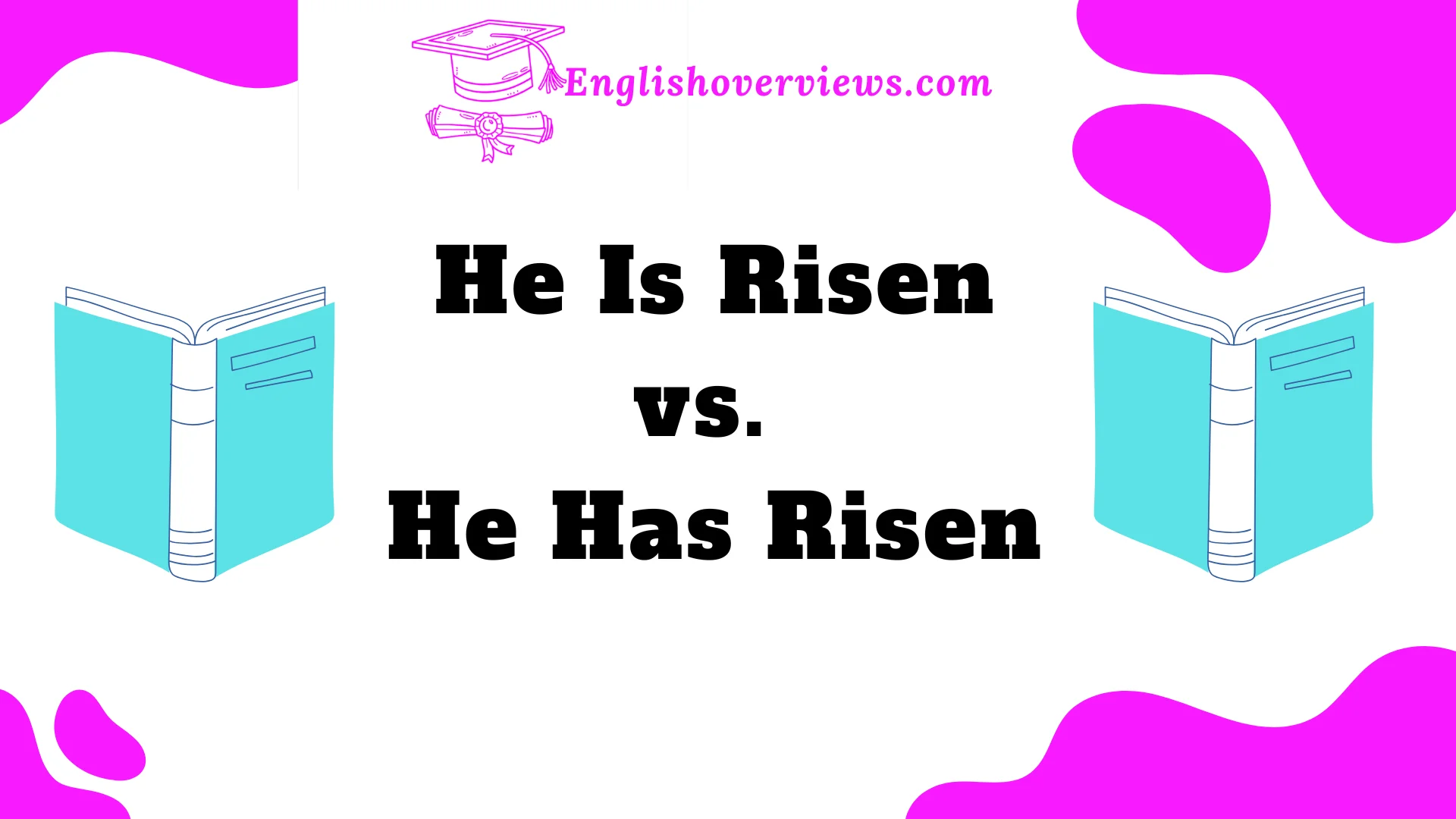The phrase “He Is Risen” holds deep significance, especially in Christian tradition. Yet, many wonder about the grammatical nuances and how it compares to “He Has Risen.” He Is Risen vs. He Has Risen This exploration isn’t just about words-it’s about uncovering layers of history, theology, and cultural impact.
Why does this phrase stand out? How has it evolved over time? And, most importantly, how does its usage reflect faith and language?
In this article, we’ll take a closer look at both phrases, breaking down their meanings, contexts, and importance.
Whether you’re a writer, a pastor, or someone intrigued by language, this guide offers clear insights and practical examples to enrich your understanding. Let’s dive into this fascinating topic.
Understanding the Phrase “He Is Risen”
What Does “He Is Risen” Mean?
The phrase “He Is Risen” is a proclamation of Christ’s Resurrection. It originates from older forms of English, where the construction emphasizes ongoing significance rather than a completed action.
- Grammatical Structure: This phrase uses the present perfect passive voice. While it may seem unusual today, it reflects how English was spoken centuries ago.
- Religious Significance: Christians use this phrase during Easter to celebrate Jesus’ victory over death, emphasizing its ongoing importance.
Example: On Easter morning, you’ll often hear, “He is risen indeed!” This response reinforces the communal celebration of faith.
The Grammatical Nuances of “He Has Risen”
How Does “He Has Risen” Differ?
In modern English, “He Has Risen” is more aligned with standard grammar rules. Here’s why:
- Focus on Completion: “Has risen” uses the present perfect tense, which highlights an action that was completed but has present relevance.
- Contemporary Usage: This phrase might feel more natural to modern speakers because it follows current grammatical norms.
A Quick Comparison:
| Phrase | Grammatical Form | Contextual Meaning |
| He Is Risen | Present perfect passive | Emphasizes ongoing significance of the action. |
| He Has Risen | Present perfect active | Focuses on the completed action. |
Why the Shift?
As English evolved, the way we express time and action also changed. While “He Has Risen” feels grammatically accurate today, “He Is Risen” carries a sense of timelessness and tradition.
Religious Tradition and Linguistic Influence
The Power of Tradition
Religious language often preserves older forms of speech. For example:
- Liturgy and Hymns: Many Easter hymns include the phrase “He Is Risen,” connecting worshippers to centuries of faith.
- Scriptural Resonance: Older translations of the Bible, such as the King James Version (KJV), cemented this phrase in religious practices.
Quote: “Language carries the weight of history, and phrases like ‘He Is Risen’ remind us of our shared spiritual heritage.” – Dr. Sarah Thompson, Linguist.
Scriptural Evidence Across Translations
How Different Translations Handle It
Bible translations vary, reflecting linguistic and theological choices. Let’s compare:
| Translation | Phrase Used | Reference |
| King James Version (KJV) | “He is risen” | Matthew 28:6 |
| New International Version (NIV) | “He has risen” | Mark 16:6 |
| English Standard Version (ESV) | “He has risen indeed” | Luke 24:34 |
Why These Differences Matter
- Literal Translation: Older versions like the KJV aim to preserve the original structure of Greek texts.
- Modern Readability: Translations like the NIV prioritize clarity for contemporary readers.
- Theological Impact: The choice of phrasing can subtly influence how the Resurrection is perceived.
Theological Implications of Phrase Variations
What Do These Phrases Convey Spiritually?
- “He Is Risen” emphasizes the eternal nature of Christ’s Resurrection. It’s not just an event in the past; it’s a continuing reality.
- “He Has Risen” highlights the historical moment of the Resurrection, focusing on its completion.
Key Insight: Both phrases underscore essential truths about the Resurrection, but they do so in different ways. Using one over the other depends on the context of the message.
Modern English Usage and Historical Context
Evolution of English Grammar
Over the centuries, English has simplified. For instance:
- Early Modern English: Forms like “He Is Risen” were common in the 16th and 17th centuries.
- Contemporary English: Modern grammar prefers active constructions, making “He Has Risen” more intuitive.
Real-World Example:
Old Hymn: “He is risen, alleluia!”
Modern Version: “Jesus has risen, hallelujah!”
Both convey the same truth, but the language reflects their era.
“He Is Risen” in Contemporary Society
Where You’ll Encounter This Phrase
- Easter Celebrations: Churches worldwide use “He Is Risen” as a central proclamation.
- Social Media: During Easter, you’ll often see posts like, “He is risen indeed!”
- Cultural Events: Passion plays and Easter musicals often include this phrase to connect audiences with tradition.
Case Study: The Viral Easter Hashtag
In 2022, the hashtag #HeIsRisen trended on social media during Easter. Posts ranged from church announcements to personal reflections, showing how deeply this phrase resonates even today.
Making the Right Choice: When to Use Each Phrase
Practical Guidelines
- Use “He Is Risen” in:
- Formal religious settings (e.g., Easter services).
- When emphasizing tradition or timelessness.
- Use “He Has Risen” in:
- Casual or modern contexts.
- Writing focused on grammar or contemporary language.
Tip: Tailor your usage to your audience and purpose. Both phrases are correct, but context is key.
FAQs: He Is Risen vs. He Has Risen
1. What is the difference between “He is risen” and “He has risen”?
“He is risen” is a traditional, biblical phrase used to proclaim Jesus’ resurrection, especially in older translations like the King James Bible. It uses an older grammatical structure where “is” functions as the auxiliary verb. “He has risen” is the modern equivalent, more aligned with contemporary grammar rules, emphasizing the completed action.
2. Why is “He is risen” still used today?
The phrase “He is risen” remains widely used in Christian liturgy, hymns, and Easter traditions because of its historical and spiritual significance. Its use evokes a sense of reverence and continuity with the language of early English translations of the Bible.
3. Is one phrase more grammatically correct than the other?
From a modern grammatical perspective, “He has risen” is more commonly correct because it follows the present perfect tense structure. However, “He is risen” is considered appropriate in a liturgical or historical context due to its traditional roots.
4. What does “He is risen” mean in Christian belief?
“He is risen” refers to the resurrection of Jesus Christ, a foundational event in Christianity. It signifies that Jesus overcame death and rose from the grave, affirming his divine nature and fulfilling biblical prophecy.
5. Can both phrases be used interchangeably?
Yes, both phrases communicate the same event—the resurrection of Jesus. However, “He is risen” is typically used in religious or ceremonial contexts, while “He has risen” might appear in conversational or modern writing styles.
Conclusion: Uniting Grammar, Tradition, and Faith
Language is more than words-it’s a bridge between history, belief, and communication. The phrases “He Is Risen” and “He Has Risen” each carry profound meanings, rooted in both grammar and faith.
Whether you’re honoring tradition or embracing modern language, understanding these nuances helps you use these phrases with confidence.
This Easter, as you hear or say “He Is Risen,” take a moment to reflect on its enduring power and significance. Language evolves, but the truths it conveys remain timeless.

Alyan Ashraf is the creative mind behind English Overviews, a platform dedicated to helping learners master the English language. Passionate about education and language development, Alyan specializes in simplifying complex English concepts, making learning accessible for students of all levels.











